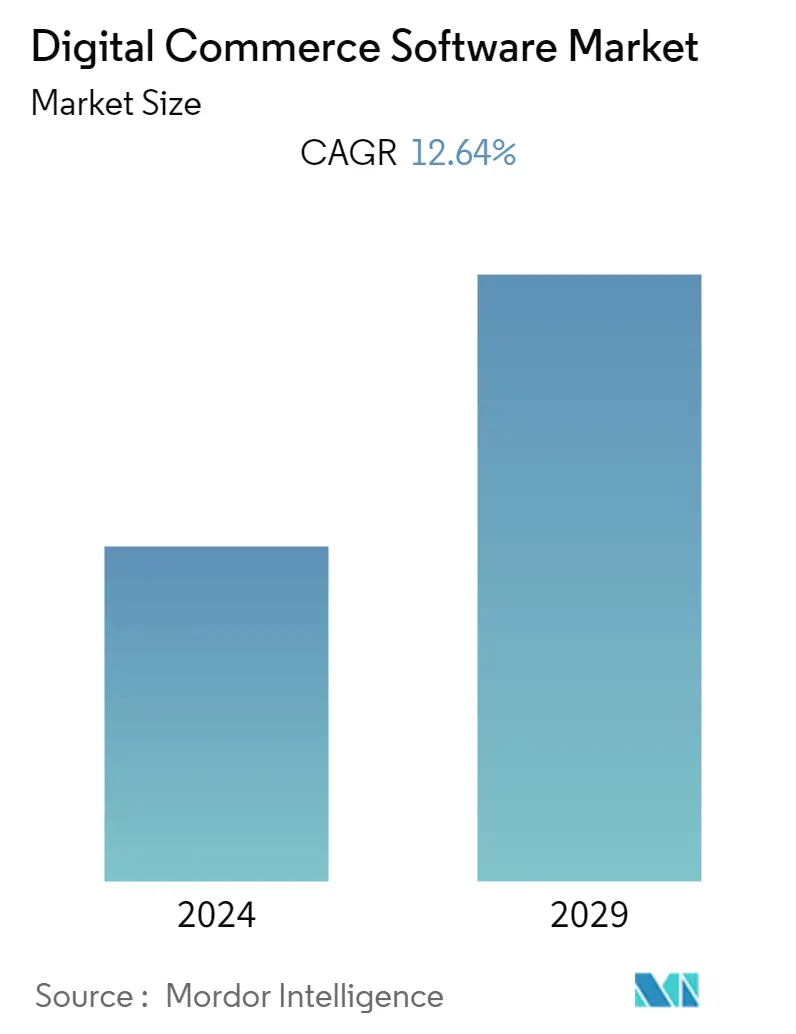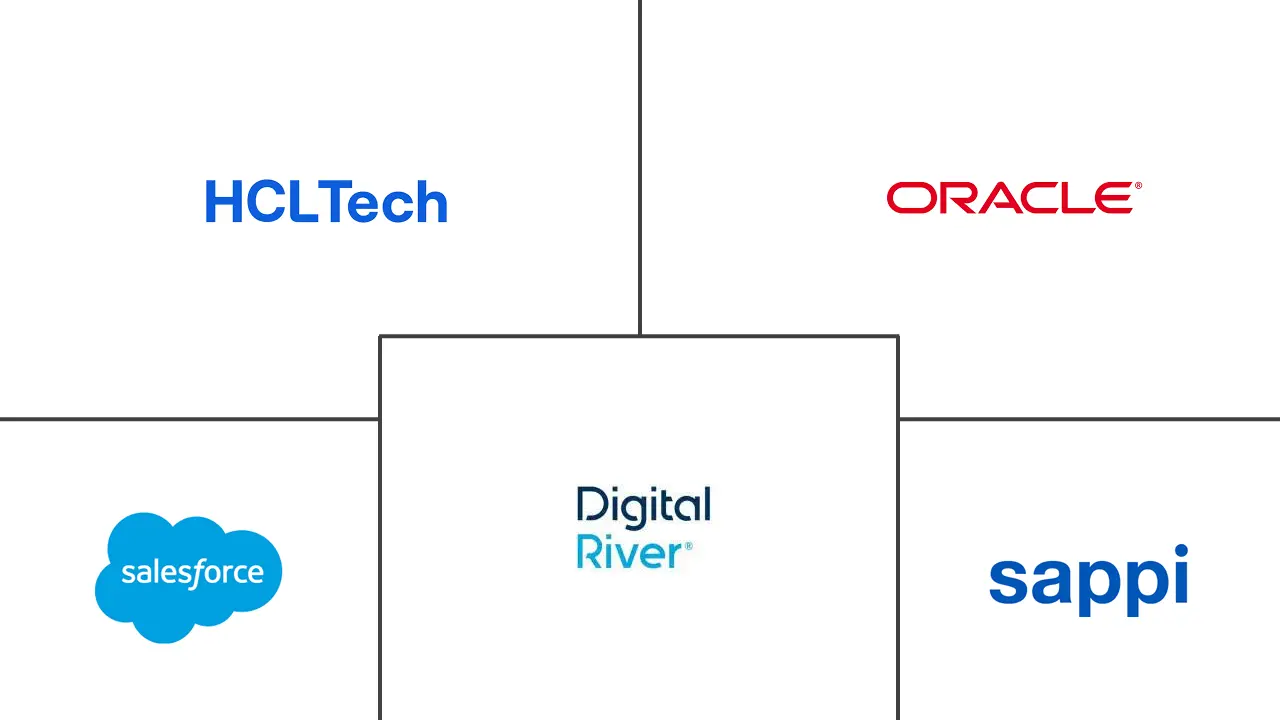Market Size of Digital Commerce Software Industry

| Study Period | 2019 - 2029 |
| Base Year For Estimation | 2023 |
| CAGR | 12.64 % |
| Fastest Growing Market | Asia Pacific |
| Largest Market | North America |
| Market Concentration | Low |
Major Players
*Disclaimer: Major Players sorted in no particular order |
Digital Commerce Software Market Analysis
The digital commerce software market is expected to register a CAGR of 12.64% during the forecast period. The market is anticipated to witness a drastic growth rate primarily due to the increase in the need for unified commerce. Since customers nowadays use an increasing number of channels throughout both the buying and owning stages, making their entire process smooth, the market for digital commerce software will witness a severe demand throughout the forecast period.
- As organizations move towards a subscription-based business model, sellers benefit greatly from repeatable, predictable revenue. Customers prefer features like convenience, cost savings, and personalized curation, which will create a massive demand for the market for digital commerce software. Moreover, cloud solutions are expanding globally, which plays a crucial role in propelling digital commerce growth due to its cost-effectiveness, automatic integrations, minimum IT investment, and ease of accessibility.
- Further, with the increase in demand for the internet of things (IoT), smart home appliances can make purchases on behalf of customers. It will thus reduce the customers' efforts to make a purchase. This digital commerce trend is creating new interactive channels and business opportunities.
- Online commerce is an indispensable vector of a merchant's strategy, and an optimized e-commerce platform translates into increased conversions and higher buying frequency. Shopify grew from a budding startup providing an additional platform for retail stores to a behemoth, servicing nearly 156,466 online stores in the United Kingdom, reflecting a growth of 218.81% and 59,590 stores in France, with an increase of 320.85% from March 2020 to January 2022. But the platform's development is most evident in Germany, where the growth rate is 480.18%, with 13,554 stores in March 2020 and 78,638 stores in January 2022. The growth is creditable to Shopify's intuitive and user-friendly operability that enables businesses to create e-commerce websites despite lacking technical knowledge and coding skills.
- However, on the flip, cybersecurity issues and raising privacy concerns are the major restraints for the market during the forecasted period.
- With the onset of the COVID-19 pandemic, there has been a significant shift to teleworking, creating tremendous data generation and a need for the cloud. When the pandemic hit hard and physical retail outlets closed or limited their operations, midmarket brands pivoted quickly to sell directly to consumers (D2C) and learned to interact with customers digitally-another contributor to the market's growth.
Digital Commerce Software Industry Segmentation
Digital commerce (D-commerce) is a type of e-commerce used by an organization that delivers and sells products online. D-commerce is used by companies that sell news, subscriptions, documents, or any form of electronic content. The digital commerce company collects payments, handles customer refunds and billing, and manages other accounting functions for online publisher clients.
The Digital Commerce Software Market is segmented by Deployment Model (On-Premises, Cloud-Based, Hybrid), End-User Industries (Retail, BFSI, Travel & Tourism, IT and Communications, and Entertainment & Media), and Geography (North America, Europe, Asia-Pacific, Latin America, Middle East & Africa). The market sizes and forecasts are provided in terms of value (USD million) for all the above segments.
| By Deployment Model | |
| On-Premise | |
| Cloud-Based | |
| Hybrid |
| By End-User Industries | |
| Retail | |
| BFSI | |
| Travel & Tourism | |
| IT & Communications | |
| Entertainment & Media |
| Geography | ||||||
| ||||||
| ||||||
| ||||||
| Rest of the World |
Digital Commerce Software Market Size Summary
The digital commerce software market is poised for significant expansion, driven by the increasing demand for unified commerce solutions. As consumers engage with multiple channels during their purchasing journey, the need for seamless integration across these platforms becomes paramount. This trend is further amplified by the shift towards subscription-based business models, which offer predictable revenue streams and cater to consumer preferences for convenience and personalization. The proliferation of cloud solutions globally is also a key factor, providing cost-effective, easily accessible, and minimally invasive IT integrations that enhance the digital commerce landscape. Additionally, the rise of IoT and smart home appliances is creating new avenues for automated purchasing, further propelling market growth.
The market is characterized by rapid technological advancements and a surge in cloud-based deployments, which have become the preferred choice for digital commerce software. These solutions not only facilitate online sales but also streamline back-end operations such as order management, logistics, and customer relationship management. The Asia Pacific region, in particular, is witnessing explosive growth due to increased smartphone penetration and high-speed internet connectivity, which have democratized access to digital marketplaces. Key players in the market are engaging in strategic mergers, acquisitions, and partnerships to enhance their offerings and expand their reach. Despite the competitive landscape, challenges such as cybersecurity and privacy concerns remain significant hurdles.
Digital Commerce Software Market Size - Table of Contents
-
1. MARKET DYNAMICS
-
2. MARKET SEGMENTATION
-
2.1 By Deployment Model
-
2.1.1 On-Premise
-
2.1.2 Cloud-Based
-
2.1.3 Hybrid
-
-
2.2 By End-User Industries
-
2.2.1 Retail
-
2.2.2 BFSI
-
2.2.3 Travel & Tourism
-
2.2.4 IT & Communications
-
2.2.5 Entertainment & Media
-
-
2.3 Geography
-
2.3.1 North America
-
2.3.1.1 United States
-
2.3.1.2 Canada
-
-
2.3.2 Europe
-
2.3.2.1 United Kingdom
-
2.3.2.2 Germany
-
2.3.2.3 France
-
2.3.2.4 Rest of Europe
-
-
2.3.3 Asia-Pacific
-
2.3.3.1 China
-
2.3.3.2 Japan
-
2.3.3.3 India
-
2.3.3.4 Rest of Asia-Pacific
-
-
2.3.4 Rest of the World
-
-
Digital Commerce Software Market Size FAQs
What is the current Digital Commerce Software Market size?
The Digital Commerce Software Market is projected to register a CAGR of 12.64% during the forecast period (2024-2029)
Who are the key players in Digital Commerce Software Market?
HCL Technologies Limited, Oracle Corporation, Digital River Inc, Sappi Limited and Salesforce Inc are the major companies operating in the Digital Commerce Software Market.

